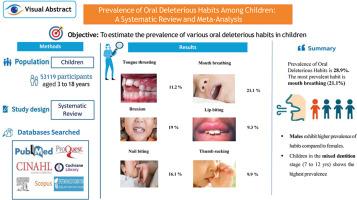儿童口腔不良习惯的患病率:一项系统回顾和荟萃分析
Q1 Medicine
Journal of oral biology and craniofacial research
Pub Date : 2025-09-20
DOI:10.1016/j.jobcr.2025.09.004
引用次数: 0
摘要
目的通过系统回顾和荟萃分析,了解儿童口腔不良习惯的流行情况,为制定有针对性的预防和干预策略提供依据。口腔习惯,如吮拇指、咬嘴唇、咬指甲、磨牙、用嘴呼吸和舌突等,都是导致牙面畸形的重要原因,这可能会导致牙合错误。了解其患病率对于制定早期干预方案以减轻长期口腔健康并发症至关重要。方法本综述方案在PROSPERO注册(CRD42024511134),并遵守PRISMA指南。在PubMed、CINAHL、Cochrane Library、Scopus、Web of Science和APA PsycINFO等多个电子数据库中进行了全面的文献检索。灰色文献通过ProQuest、谷歌Scholar和Shodhganga数据库进行识别。对符合条件的研究进行meta分析。结果在1211份确定的记录中,54项研究共包括53119名年龄在3-18岁的儿童。口腔不良习惯的总患病率为28.9%,其中口呼吸(21.1%)和磨牙(19.0%)是最常见的报告习惯。男性(29.4%)略高于女性(26.9%)。在男性中,磨牙是最常见的习惯(19.9%),而咬唇是最不常见的(6.1%)。在女性中,磨牙也是最普遍的(17.6%),咬唇是最少的(5.9%)。6-12岁儿童患病率最高(32.1%),3-6岁次之(25.2%),青少年患病率最低(17.1%)。结论儿童口腔不良习惯普遍存在,对口腔颌面发育有不良影响。早期发现和及时干预是预防错牙合和减少长期正畸治疗负担的关键。本文章由计算机程序翻译,如有差异,请以英文原文为准。

Prevalence of Oral Deleterious Habits among children: A systematic review and meta-analysis
Objective
This systematic review and meta-analysis aim to estimate the prevalence of oral deleterious habits in children, providing essential evidence for targeted prevention and intervention strategies.
Introduction
Oral habits such as thumb-sucking, lip biting, nail-biting, bruxism, mouth breathing, and tongue thrusting significantly contribute to dentofacial anomalies, which can potentially result in malocclusions. Understanding their prevalence is crucial for developing early intervention protocols to mitigate long-term oral health complications.
Methods
The review protocol was registered with PROSPERO (CRD42024511134) and adhered to the PRISMA guidelines. A comprehensive literature search was conducted across multiple electronic databases, including PubMed, CINAHL, Cochrane Library, Scopus, Web of Science, and APA PsycINFO. Grey literature was identified through ProQuest, Google Scholar, and the Shodhganga database. Eligible studies were subjected to meta-analysis.
Results
Out of 1211 identified records, 54 studies encompassing a total of 53,119 children aged 3–18 years were included. The pooled prevalence of oral deleterious habits was 28.9 %, with mouth breathing (21.1 %) and bruxism (19.0 %) being the most commonly reported habits. The habits were slightly more prevalent among males (29.4 %) than among females (26.9 %). In males, bruxism was the most frequent habit (19.9 %), whereas lip biting was the least common (6.1 %). Among females, bruxism was also most prevalent (17.6 %), with lip biting being the least reported (5.9 %). The prevalence was highest in children aged 6–12 years (32.1 %), followed by those aged 3–6 years (25.2 %), and lowest among adolescents (17.1 %).
Conclusion
Oral deleterious habits are prevalent among children and can have adverse effects on dental and maxillofacial development. Early identification and timely intervention are critical to preventing malocclusions and reducing the burden of long-term orthodontic treatment.
求助全文
通过发布文献求助,成功后即可免费获取论文全文。
去求助
来源期刊

Journal of oral biology and craniofacial research
Medicine-Otorhinolaryngology
CiteScore
4.90
自引率
0.00%
发文量
133
审稿时长
167 days
期刊介绍:
Journal of Oral Biology and Craniofacial Research (JOBCR)is the official journal of the Craniofacial Research Foundation (CRF). The journal aims to provide a common platform for both clinical and translational research and to promote interdisciplinary sciences in craniofacial region. JOBCR publishes content that includes diseases, injuries and defects in the head, neck, face, jaws and the hard and soft tissues of the mouth and jaws and face region; diagnosis and medical management of diseases specific to the orofacial tissues and of oral manifestations of systemic diseases; studies on identifying populations at risk of oral disease or in need of specific care, and comparing regional, environmental, social, and access similarities and differences in dental care between populations; diseases of the mouth and related structures like salivary glands, temporomandibular joints, facial muscles and perioral skin; biomedical engineering, tissue engineering and stem cells. The journal publishes reviews, commentaries, peer-reviewed original research articles, short communication, and case reports.
 求助内容:
求助内容: 应助结果提醒方式:
应助结果提醒方式:


